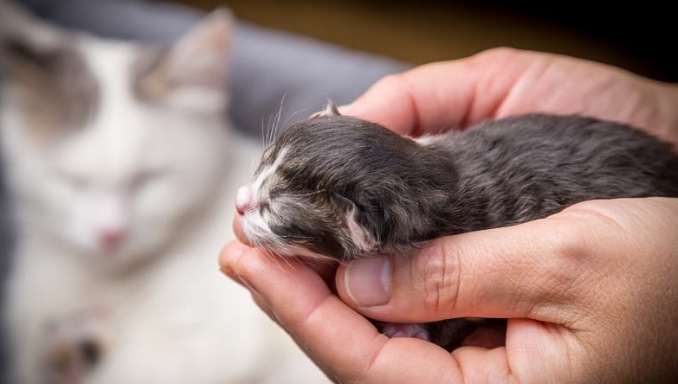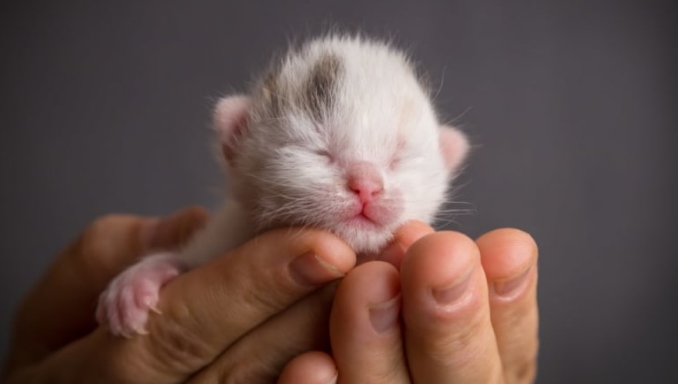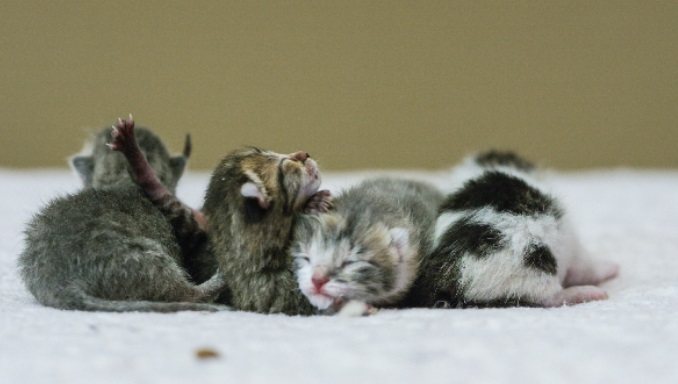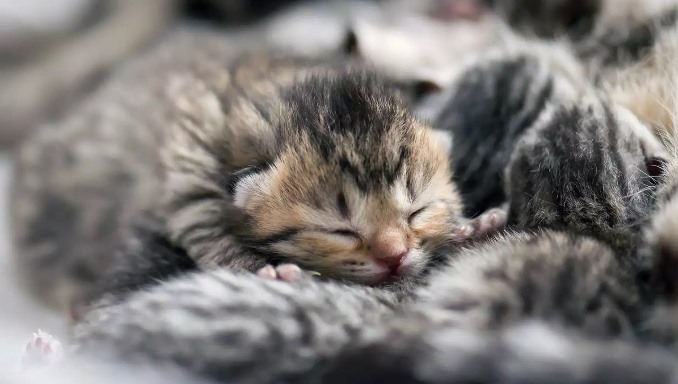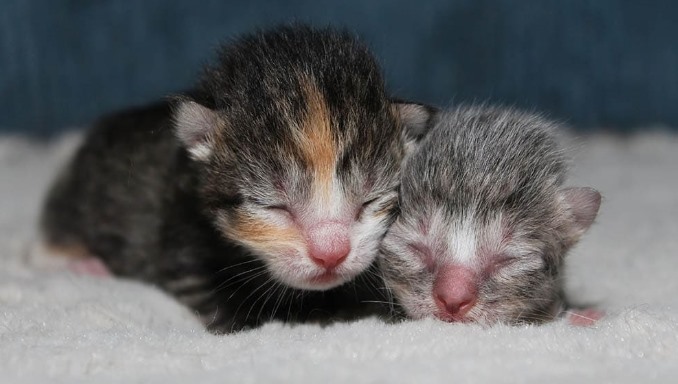How Many Kittens Can A Cat Have?
Cats are one of the most popular house pets in the world. They are small, adorable, and furry. People love cats because they are independent and playful. Cats can be great companions, but they also require a lot of care. If you’re thinking about getting a cat, there are some things you need to know first.
A common question that cat owners often ask is How many kittens can a cat have? This isn’t an easy question to answer as there are so many variables, such as the age and health of the cat, as well as the time of year. In general, however, cats can have anywhere from one to twelve kittens at a time. So what do you need to know about kitten litters? Keep reading for more information.
When it comes to having kittens, there are two main types of litters: single and multi-kitten. As you might expect, a single kitten litter will only have one or two kittens, while a multi-kitten litter can have up to twelve. Of course, the number of kittens in a litter can also depend on the age and health of the mother cat.
if you’re thinking about getting a kitten, there are a few things you need to take into consideration. For example, you’ll need to decide if you want a single kitten or a multi-kitten litter. You should also think about the age and health of the mother cat, as well as the time of year. With all of these factors in mind, you’ll be able to choose the right litter for your new feline friend.
As a cat owner, you may be interested in knowing about the factors that can affect your feline friend’s fertility. By understanding these factors, you can take steps to help ensure your cat has the best chance of becoming pregnant and having healthy kittens. In this blog post, we will also discuss some of the most important factors that influence a cat’s fertility. We will also provide tips on how to help your cat get pregnant.
See more: How Many Pups Can A Dog Have?
Cat Fertility – How Many Kittens Can a Cat Have?
Cats are often thought of as low-maintenance pets, but that doesn’t mean they don’t need care and attention. One important area of cat care is reproduction. If you’re thinking about breeding your cat, or if you just want to be prepared in case your cat becomes pregnant, it’s important to understand some basic information about feline reproduction.
Cats are induced ovulators, which means that they do not ovulate (release eggs) on their own. Instead, ovulation is triggered by mating. This is different from humans and other animals, who ovulate regularly whether or not they mate.
The length of the cat’s reproductive cycle varies depending on the individual cat, but is generally around 21 days. After mating, it takes roughly 7-10 days for the eggs to be released.
Once the eggs are released, they travel down the fallopian tubes and into the uterus. If fertilization occurs, pregnancy begins. The average gestation period (time from fertilization to birth) for cats is 63 days, although it can range from 58-70 days.
During pregnancy, it’s important to give your cat extra love and attention. She may be feeling nauseous or have a decreased appetite, so make sure she has access to fresh water and a nutritious diet. Avoid giving her any over-the-counter medications without first consulting your veterinarian.
After 63 days, your cat will give birth to her kittens. Each litter can range in size from one to eight kittens, although the average is four. Once the kittens are born, they will need to be fed every two to three hours. Your cat will likely be able to take care of them on her own, but you should check in on them regularly to make sure everything is going smoothly.
After eight weeks, the kittens will be old enough to be spayed or neutered and vaccinated. They can also be put up for adoption at this time.
Breeding cats can be a rewarding experience, but it’s important to do your research beforehand and be prepared for the challenges that come with it. With a little knowledge and care, you can help ensure a healthy pregnancy and litter of kittens.
Kitten season is the time of year when litters of kittens are born. It typically occurs in the spring and summer, although it can happen any time of year. During kitten season, shelters see a surge in the number of kittens coming in, often without their mothers. This can be overwhelming for shelters, which is why it’s so important for people to spay and neuter their cats.
According to the Humane Society, cats can have one to twelve kittens per litter and up to three litters per year. This means that a single cat could potentially produce dozens of kittens in just one year. While this may be good news for kitten lovers, it can be a challenge for animal shelters trying to find homes for all these new animals.
It is important to remember that before you add a kitten to your family, you should consider whether you can provide enough food, water, toys, and veterinarian care for another pet. If not, please contact your local animal shelter and ask about adopting one of their many wonderful cats waiting for a home.
How Many Kittens Can a Cat Have? – Some Popular Cat Breeds
While all cats are capable of having large litters, some breeds are more likely to have multiple kittens than others. The following list includes some popular cat breeds and the average number of kittens they can have per litter:
- Siamese: 4-6 kittens
- Persian: 4-6 kittens
- Manx: 4-6 kittens
- Birman: 4-6 kittens
- Sphynx: 2-4 kittens
- Russian Blue: 2-4 kittens
- British Shorthair: 2-5 kittens
- Ragdoll: 6-8 kittens
- American Shorthair: 6-8 kittens
- Scottish Fold: 5 kittens on average
- Exotic Shorthair: 4-5 kittens
- Norwegian Forest: 4 kittens on average.
- Ocicat: 6-8 kittens
Some cats may have larger litters while others may only have one or two kittens. Siamese cats usually have between two and five kittens per litter. Birman cats usually have between three and five kittens per litter. Ragdoll cats often have six or more kittens per litter. Maine Coon cats usually have between four and six kittens per litter.
While there are some cat breeds that tend to have larger litters, it is really the individual cat that will determine how many kittens she will have. Some cats may only have one or two kittens, while others may have six or more. There is no way to predict exactly how many kittens a cat will have. However, there are some things that can affect litter size, such as the age of the cat and whether she has had kittens before.
If you’re thinking about breeding your cat, it’s important to do your research beforehand and be prepared for the challenges that come with it. With a little knowledge and care, you can help ensure a healthy pregnancy and litter of kittens.
Factors that Affect a Cat’s Fertility
There are many factors that can affect a cat’s fertility. Some of these factors include age, health, diet, and stress levels.
Age is one of the most important factors when it comes to fertility. Cats typically reach sexual maturity between 6 and 12 months old, but some may not be able to breed until they are a bit older. As cats age, their fertility declines. This is especially true for female cats, who are more likely to experience problems with their reproductive organs as they age.
Health is another important factor that can affect fertility. Cats that are sick or have certain health conditions may have difficulty conceiving or carrying a pregnancy to term. Diet also plays a role in fertility. Cats that are not well-nourished may have trouble reproducing.
Diet and health are closely related, so it’s important to make sure your cat is getting all the nutrients she needs from her food. If you’re concerned about your cat’s diet, talk to your vet about the best way to ensure she’s getting everything she needs.
Stress can also affect a cat’s ability to breed. Cats that are constantly exposed to high levels of stress may have difficulty getting pregnant or may miscarry if they do become pregnant.
Factors Affecting the Number of Kittens in a Litter
There are several factors that can affect the number of kittens in a litter. These include:
- The age of the dam (mother cat): Older cats tend to have smaller litters than younger cats.
- The number of times the dam has been bred: First-time mothers often have smaller litters than experienced mothers.
- The size of the dam: Larger dams tend to have larger litters than smaller dams.
- The breed of the dam: Some breeds, such as Siamese and Orientals, tend to have smaller litters than other breeds.
- The health of the dam: Healthy dams are more likely to have large litters than unhealthy dams.
- The time of year: Litters born in the spring and summer tend to be larger than those born in the fall and winter.
Kitten mortality rates are also affected by these factors. Larger litters tend to have higher mortality rates than smaller litters, as there is competition for food and resources. Kittens born to first-time mothers also tend to have higher mortality rates, as the mother may not yet know how to properly care for them.
The best way to ensure a healthy litter of kittens is to have your dam checked by a veterinarian before breeding. The veterinarian can help you determine if she is healthy enough to have a litter and can advise you on the best time to breed her. They can also help you choose a stud (male cat) who is compatible with your dam and likely to produce healthy kittens.
When breeding cats, it’s important to be prepared for the challenges that come with it. With a little knowledge and care, you can help ensure a successful pregnancy and litter of kittens.
How to Determine the Litter Size of Your Cat
There are a few things to take into account when trying to determine the litter size of your cat. The first is the age of your cat. If your cat is still young, her litter size will likely be smaller than if she were older. Secondly, consider the breed of your cat. Some breeds tend to have larger litters than others. Finally, think about the health of your cat. If she is pregnant and in good health, she will likely have a larger litter than if she were pregnant and unhealthy.
If you take all of these factors into account, you should be able to come up with a pretty good estimate of your cat’s litter size. However, keep in mind that there is no guarantee that your cat will have the exact number of kittens you are expecting. She may have more or fewer, so it is always best to be prepared for anything.
Previous numbers of kittens in the litter: If this is not your cat’s first pregnancy, you can take a look at her previous litters to get a better idea of how many kittens she is likely to have this time around.
X-ray and Ultrasounds: If you want a more accurate idea of how many kittens your cat is carrying, you can ask your veterinarian to perform an x-ray or ultrasound. These procedures will allow your vet to get a good look at the developing kittens and give you a more precise number.
The bottom line is that it can be very difficult to determine the litter size of your cat, but there are a few things you can do to get a better idea. Ultimately, though, you will just have to wait and see how many kittens your cat has when she gives birth.
Helping Your Pregnant Cat Give Birth
Once your cat is pregnant, there are a few things you can do to help her through the birthing process.
First, provide her with a clean, quiet place to have her kittens. This could be a laundry room, bathroom, or spare bedroom. Make sure the area is warm and free from drafts. You may also want to put a litter box in the area for her to use.
Second, make sure she has access to fresh water and food at all times. Pregnant cats need more calories than they did before they were pregnant, so you may need to increase her food intake. Talk to your vet about how much food your cat should be eating during pregnancy.
Third, provide her with a scratching post or toy to help her relieve stress. Pregnant cats can be prone to anxiety, so it’s important to provide them with things that will help them relax.
Finally, keep an eye on her during the birthing process. If you notice any problems, such as excessive bleeding or the kittens not moving, call your vet immediately.
Some Tips on Helping Your Pregnant Cat Give Birth:
1. Create a calm, quiet environment for your cat to give birth in. This means keeping other pets and children away from the area, and making sure there are no loud noises or stressful activity going on nearby.
2. Help your cat get into a comfortable position for giving birth. This may mean placing a towel or soft blanket underneath her, or offering her a box or other small enclosed space to nest in.
3. Do not try to intervene unless there is a problem; let nature take its course.
4. If you see that the babies are not coming out easily, or if your cat seems to be in distress, contact your veterinarian immediately.
5. After the birth, help your cat clean up her kittens by gently wiping them with a warm, damp cloth.
6. Make sure your cat has plenty of fresh water and food available, and give her some peace and quiet to recover from the ordeal of childbirth.
Caring for Newborn Kittens
Newborn kittens are so incredibly cute, its no wonder that people go crazy over them! But before you bring home a new bundle of joy, there are some things you need to know about caring for newborn kittens.
First and foremost, kittens need to be kept warm. Their tiny bodies are not yet able to regulate their own temperature, so it is important to make sure they are in a warm, draft-free environment. A heating pad set on low or a hot water bottle wrapped in a towel can provide some gentle warmth, but be sure to keep an eye on the kittens so that they don’t get too hot.
Kittens also need to eat frequently. They should be fed every two to three hours, even through the night. A special kitten formula is available at pet stores, or you can use whole milk. Be sure to warm the milk before feeding it to the kittens, as they will not be able to digest cold milk properly. To feed the kittens, use a syringe or an eyedropper to slowly drip the formula into their mouths. Be careful not to overfeed them, as this can cause them to vomit. After each feeding, burp the kittens by gently rubbing their backs.
Newborn kittens are not yet able to use a litter box, so you will need to take care of their bathroom needs for them. Gently wipe them with a warm, damp cloth after each feeding. It is also important to keep their bottom area clean and dry to prevent infection. You’ll also need to keep the kittens clean. This includes bathing them, trimming their nails, and cleaning their ears. It’s best to wait until they’re a few weeks old to give them a bath, as they can easily catch a cold if they get too wet. You can clean their nails with a nail clipper designed for kittens. To clean their ears, use a cotton ball soaked in warm water.
Finally, newborn kittens are very fragile and need to be handled carefully. Avoid picking them up by the scruff of their necks, as this can injure their delicate spine. Instead, cup them in your hands or use a soft towel to support their bodies. Provide the kittens with a safe place to sleep. This could be a box lined with towels or a special kitten bed. Make sure the area is warm and free from drafts.
Caring for kittens can be a lot of work, but it’s also very rewarding. With a little bit of care and patience, you will have your brand new kittens thriving in no time!
Advantages and Disadvantages of Cats Giving Birth to Too Many Kittens
One advantage of having too many kittens is that there will always be a cat around to keep you company. Another advantage of having lots of kittens is that they can keep each other entertained, so you won’t have to worry about them being bored.
A disadvantage of having too many kittens is that it can be difficult to take care of them all and you may not have enough time to give each one the attention they need. Another disadvantage of having lots of kittens is that they can be a bit overwhelming, especially if you’re not used to having animals around the house. If you’re thinking about getting a cat, make sure you do your research so you know how many kittens to expect and whether or not you’ll be able to handle them.
To Spay Or Neuter Your Cat – Should or Shouldn’t
The main reason to spay or neuter your cat is to help reduce the number of homeless animals. There are already too many animals in shelters and not enough homes for them all. By spaying or neutering your cat, you can help make a difference.
Another reason to spay or neuter your cat is that it can help improve their health. For example, spaying a female cat can help reduce the risk of mammary cancer. Neutering a male cat can help reduce the risk of testicular cancer. Spaying or neutering your cat can also help reduce the risk of other diseases and disorders.
There are also behavioral benefits to spaying or neutering your cat. For example, spaying a female cat can help reduce the chances of her spraying urine to mark her territory. Neutering a male cat can help reduce his aggressive behavior and roaming instincts. It can also help to reduce the number of unwanted kittens being born each year. And finally, it can help to make your cat less likely to roam and get lost.
Of course, there are also some disadvantages to spaying or neutering your cat. The biggest disadvantage is that it is major surgery. There is always the risk of complications, such as infection. There is also the cost to consider. The average cost of spaying or neutering a cat is between $50 and $200.
Ultimately, the decision of whether or not to spay or neuter your cat is a personal one. There are pros and cons to both sides. It’s important to do your research and make the decision that is best for you and your cat.
FAQs
How many kittens does a cat have in first litter?
Typically, a cat will have three to five kittens in their first litter. However, there can be as many as eight kittens. If the mother cat is small, there may only be one or two kittens. Some litters can have up to 12 kittens, but this is quite rare. The average litter size for a cat is four kittens.
How many kittens can a cat have in 1 year?
The average litter size for cats is four kittens, but litters of six or more are not uncommon. Therefore, a cat could have up to 24 kittens in one year. However, most cats will only have one to two litters per year.
Can you touch newborn kittens?
Yes, it is safe to touch newborn kittens. However, it is important to be gentle and wash your hands before and after handling them. If you are not comfortable handling them, it is best to let their mother do it.
Can a 3 month old kitten get pregnant?
Yes, a 3 month old kitten can get pregnant. However, it is not recommended to allow your kitten to become pregnant at such a young age. Kittens are not fully mature when they reach 3 months old, and their bodies are not ready to handle the stresses of pregnancy and childbirth. If you do allow your kitten to become pregnant at 3 months old, she is at risk for complications during pregnancy and delivery, as well as health problems for her kittens. It is best to wait until your kitten is at least 6 months old before allowing her to become pregnant.
How long does cat pregnant last?
Pregnancy in cats usually lasts between 64 and 67 days, although some litters can be born as early as 62 days or as late as 72 days. Therefore, it is best to consult with your veterinarian if you think your cat may be pregnant so that they can give you a more accurate due date. If your cat goes past their due date, they may need to be induced.
What are the first signs of a cat being pregnant?
Some of the first signs that a cat is pregnant include appetite changes, weight gain, nesting, and increased vocalization. However, these signs can also be indicative of other health problems, so it is best to consult with your veterinarian if you think your cat may be pregnant. If your cat is pregnant, your veterinarian will be able to confirm it with a physical examination and ultrasound.
What is the average lifespan of a spayed or neutered cat?
The average lifespan of a spayed or neutered cat is 14 years. However, some cats can live to be 20 years old or more. The average lifespan of an unspayed or unneutered cat is 12 years. Therefore, spaying or neutering your cat can add two years to their life expectancy.
What is the best age to spay or neuter a cat?
The best age to spay or neuter a cat is between 4 and 6 months old. This is before they reach sexual maturity and start to roam or fight. However, older cats can also be spayed or neutered. If you have an older cat that is not spayed or neutered, it is best to consult with your veterinarian to see if they are a good candidate for the surgery.
How do I know when my cats ready to give birth?
There are several signs that your cat is about to give birth, including:
1. She will start to look for a quiet, private place to nest.
2. Her temperature will drop a few degrees just before labor begins.
3. Her appetite will decrease and she may vomit a little.
4. She will start to experience contractions.
5. She will produce a mucus plug from her vagina, which is an indication that labor is about to begin.
If you notice any of these signs, it’s important to provide your cat with a clean, quiet place to have her kittens. Once she goes into labor, she should be left alone to do so, as intervention is usually unnecessary. However, if you have any concerns, or if the labor seems to be taking a long time, you should contact your veterinarian.
Conclusion
This is an interesting question that does not have a definitive answer. Some people believe that a cat can have as many kittens as it wants, while others think the number of kittens a cat can have is limited by its health and age. Ultimately, the number of kittens a cat has will depend on the individual cat and its particular circumstances.
While the answer to this question is largely dependent on the individual cat, on average a healthy feline can have around six kittens per litter. Of course, there are many variables that can affect this number, such as the age and health of the mother cat, as well as environmental factors.
We hope this post has helped you better understand how many kittens a cat can have. If you still have questions, please contact us and we would be happy to help.
Above is the article “How many kittens can a cat have?” Thanks for reading!
Further reading:

